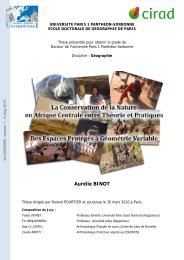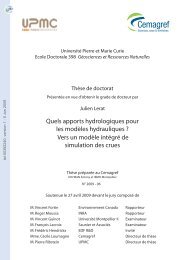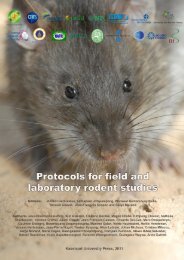Partie C : Résultats – Chapitre C-I1. Introductiontel-00486649, <strong>ver</strong>sion 1 - 26 May 2010O<strong>ver</strong> the past few <strong>de</strong>ca<strong><strong>de</strong>s</strong>, the mining industry has produced a large amount of acid,metal-rich waste which has often created a serious risk to the soil environment (1). The natureand extent of this contamination is highly variable, <strong>de</strong>pending on the nature of each mine’sore body and its associated geological strata and climate (2). It is, therefore, important tomake an accurate assessment of the availability and toxicity of heavy metals in each pollutedsoil.Phytoextraction is a technology that uses plants to extract metals from contaminatedsoils and accumulate them in harvestable parts which can then be removed from the site (3,4).This appears to be a cost-effective, non-intrusive and environmentally friendly techniquecompared to conventional techniques and promises to be a phytotechnology with greatpotential for solving the problem of soils polluted with metals (5). Improving thephytoextraction process is a primary goal of current research. There are se<strong>ver</strong>al avenues ofstudy for increasing the efficiency of remediation. (i) I<strong>de</strong>ntify new hyperaccumulator specieswith the requisite properties such as high biomass, high metal uptake and ease of propagation.(ii) Increase the biomass of the hyperaccumulator plant by adding fertilizer or using plantgrowth hormones (e.g. IAA, gibberellins or cytokinin), associating them with Plant GrowthPromoting Rhizobacteria (PGPR) (6,7). (iii) Inoculate the soil with a bacterial communityimproving the availability of the metals (8) and/or with Arbuscular Mycorrhizal Fungi (AMF)(9). (iv) Increase the metal content in the plant by the addition of chelating agents such asglycoletherdiamine tetra-acetic acid (EGTA) or NTA (nitrilotriacetic acid) (7,10,11).Little is known about how the relationships between roots, microorganisms and soilfauna in the rhizosphere affect plant growth and metal uptake. Only a few studies have beencarried out into microorganism-assisted metal extraction by plants. Braud et al. (8) showedthat inoculating the soil with free cells of R. metallidurans gave a five-fold increase in Craccumulation in maize shoots and inoculating the soil with immobilized P. aeruginosa cellsgave five-fold and three-fold increases in Cr and Pb uptake, respectively. There have been nostudies on the effects of soil fauna on phytoremediation. Earthworms are importantcomponents of the rhizosphere ecosystem and can significantly increase plant production byimproving soil fertility and nutrient cycling (12), although other <strong>interactions</strong> (e.g. betweenearthworms and root pathogens or beneficial soil microorganisms) may also affect plants (13).Some earthworms (for example Lumbricus <strong>terre</strong>stris, Lumbricus rubellus, or Aporrecto<strong>de</strong>a57
Partie C : Résultats – Chapitre C-Icaliginosa) can <strong>sur</strong>vive in soils polluted with heavy metals and can even accumulate heavymetals such as Cd, Pb, Cu and Zn (14-16). Earthworms can also increase metal availability insoil by burrowing and casting and can, therefore, modify the efficiency of phytoremediation(17). The presence of earthworms can also increase Zn availability (18), although the authorssuggested that the main reason for the increase in Zn uptake by the plants was probably theincrease in the production of dry matter stimulated by earthworms.tel-00486649, <strong>ver</strong>sion 1 - 26 May 2010Lantana camara L., which is an hyperaccumulating plant owing to its remarkablecapacity to extract lead and cadmium from polluted soils in Vietnam (19), has been suggestedas a mo<strong>de</strong>l species for research on phytoextraction of metals. Howe<strong>ver</strong>, the speciesPontoscolex corethrurus (Oligochaeta, Glossoscolecidae), which is an endogenous tropicalearthworm, is <strong>ver</strong>y common in wetlands in Vietnam in both polluted and unpolluted areas.The burrowing and casting activities of this species have consi<strong>de</strong>rable impact on soil structure(20). Moreo<strong>ver</strong>, this species plays an important role on the rates of mineral N availability forplants, the assimilation of phosphorous and in the recycling of other nutrients and could,therefore, be involved in phyoextraction of metals (21,22).This study sets out to <strong>de</strong>termine the impact of the Pontoscolex corethrurus earthwormon Lantana camara growth and the phytoextraction process in soil artificially contaminatedwith lead at different levels.2. Materials and methods2.1. Soil collection and characterizationUnpolluted soil was collected from the A1 horizon in the grounds of the Phu AnEcomuseum, Binh Duong Province, Vietnam. It was an acid (pH=5), sandy (19.9% sand,72.2% silt, and 7.9% clay) soil with an intermediate fertility of 34.2% OM, 4.9% total N,7.9% P and tested negative for heavy metal pollution. The soil was sieved to < 5 mm, airdriedand mixed to obtain homogenous soil samp<strong>les</strong>. Experimental pots (microcosms) werefilled with 10 kg of dry soil. The soil was artificially contaminated with lead(CH 3 COO) 2 .3H 2 O at 500 mg.kg -1 and 1000 mg.kg -1 dry weight (DW). The soil’s fieldcapacity was <strong>de</strong>termined using five additional microcosms by weighing the pots after drainingthe soil for 24 hours.58
- Page 7 and 8:
tel-00486649, version 1 - 26 May 20
- Page 9 and 10:
4. Discussion…………………
- Page 13 and 14:
Introduction généraledifférentes
- Page 15 and 16:
Partie A : Synthèse bibliographiqu
- Page 20 and 21: Partie A : Synthèse bibliographiqu
- Page 23 and 24: Partie A : Synthèse bibliographiqu
- Page 25 and 26: Partie A : Synthèse bibliographiqu
- Page 27 and 28: Partie A : Synthèse bibliographiqu
- Page 29 and 30: Partie A : Synthèse bibliographiqu
- Page 31 and 32: Partie A : Synthèse bibliographiqu
- Page 33 and 34: Partie A : Synthèse bibliographiqu
- Page 35 and 36: Partie A : Synthèse bibliographiqu
- Page 37 and 38: Partie A : Synthèse bibliographiqu
- Page 39 and 40: Partie A : Synthèse bibliographiqu
- Page 41 and 42: Partie B : Matériel et MéthodesI/
- Page 43 and 44: Partie B : Matériel et MéthodesPo
- Page 45 and 46: Partie B : Matériel et MéthodesII
- Page 47 and 48: Partie B : Matériel et MéthodesPo
- Page 49 and 50: Partie B : Matériel et MéthodesFi
- Page 51 and 52: Partie B : Matériel et MéthodesV/
- Page 53 and 54: Partie B : Matériel et MéthodesV.
- Page 55 and 56: Partie B : Matériel et Méthodessp
- Page 57 and 58: Partie B : Matériel et MéthodesL
- Page 59 and 60: Partie B : Matériel et MéthodesCo
- Page 61 and 62: Partie C : Résultatstel-00486649,
- Page 63 and 64: Partie C : Résultats - Chapitre C-
- Page 65 and 66: Partie C : Résultats - Chapitre C-
- Page 67 and 68: iomasse sec (g)Partie C : Résultat
- Page 69: Partie C : Résultats - Chapitre C-
- Page 73 and 74: Partie C : Résultats - Chapitre C-
- Page 75 and 76: Partie C : Résultats - Chapitre C-
- Page 77 and 78: Partie C : Résultats - Chapitre C-
- Page 79 and 80: Partie C : Résultats - Chapitre C-
- Page 81 and 82: Partie C : Résultats - Chapitre C-
- Page 83 and 84: Partie C : Résultats - Chapitre C-
- Page 85 and 86: Partie C : Résultats - Chapitre C-
- Page 87 and 88: Partie C : Résultats - Chapitre C-
- Page 89 and 90: Partie C : Résultats - Chapitre C-
- Page 91 and 92: Partie C : Résultats - Chapitre C-
- Page 93 and 94: Partie C : Résultats - Chapitre C-
- Page 95 and 96: Partie C : Résultats - Chapitre C-
- Page 97 and 98: Activité enzymatiqueActivité enzy
- Page 99 and 100: Partie C : Résultats - Chapitre C-
- Page 101 and 102: Partie C : Résultats - Chapitre C-
- Page 103 and 104: Partie C : Résultats - Chapitre C-
- Page 105 and 106: AgV/T/SVS /T/SVAgP/T/SPS/T/SPAgP/T/
- Page 107 and 108: Partie C : Résultats - Chapitre C-
- Page 109 and 110: AgPTSP1AgPTSP2AgPTSP3AgPTSPV1AgPTSP
- Page 111 and 112: AWCDPartie C : Résultats - Chapitr
- Page 113 and 114: Partie C : Résultats - Chapitre C-
- Page 115 and 116: Partie C : Résultats - Chapitre C-
- Page 117 and 118: Partie C : Résultats - Chapitre C-
- Page 119 and 120: Nombre morphologiePartie C : Résul
- Page 121 and 122:
Partie C : Résultats - Chapitre C-
- Page 123 and 124:
Partie C : Résultats - Chapitre C-
- Page 125 and 126:
Partie C : Résultats - Chapitre C-
- Page 127 and 128:
Partie C : Résultats - Chapitre C-
- Page 129 and 130:
Partie C : Résultats - Chapitre C-
- Page 131 and 132:
Partie D : Discussion - Conclusion
- Page 133 and 134:
Partie D : Discussion - Conclusion
- Page 135 and 136:
Partie D : Discussion - Conclusion
- Page 137 and 138:
RéférencesAAbbass, M.I. and Razak
- Page 139 and 140:
Référencestel-00486649, version 1
- Page 141 and 142:
Référencestel-00486649, version 1
- Page 143 and 144:
Référencestel-00486649, version 1
- Page 145 and 146:
RéférencesGregory, P.J. (2006). R
- Page 147 and 148:
RéférencesJiménez, J.J., Cepeda,
- Page 149 and 150:
RéférencesKuperman, R.G., Carreir
- Page 151 and 152:
RéférencesLoué, A. (1993). Oligo
- Page 153 and 154:
RéférencesNNaidu, R., Bolan, N.S.
- Page 155 and 156:
Référencestel-00486649, version 1
- Page 157 and 158:
Référencestel-00486649, version 1
- Page 159 and 160:
RéférencesTorsvik, V., and Øvra
- Page 161 and 162:
tel-00486649, version 1 - 26 May 20
- Page 163 and 164:
Annexe 2 : Liste de morphologies fo
- Page 165 and 166:
tel-00486649, version 1 - 26 May 20
- Page 167 and 168:
tel-00486649, version 1 - 26 May 20
- Page 169:
SUMMARYtel-00486649, version 1 - 26
















